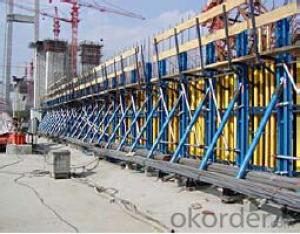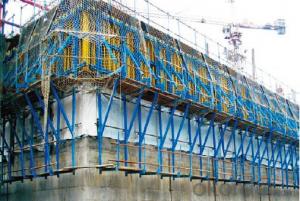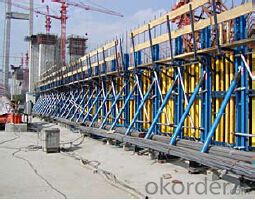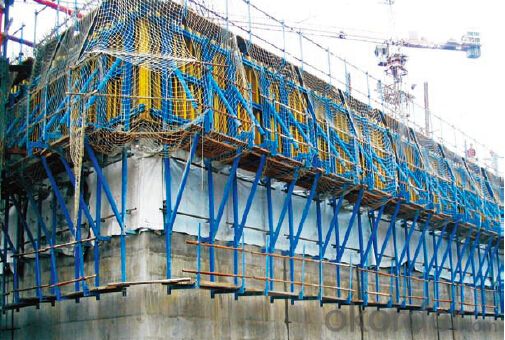Single-Side Climbing Bracket for formwork and scaffolding systems
- Loading Port:
- Tianjin
- Payment Terms:
- TT OR LC
- Min Order Qty:
- 50 m²
- Supply Capability:
- 1000 m²/month
OKorder Service Pledge
OKorder Financial Service
You Might Also Like
Single-side Climbing Bracket SCB180:
With CNBM SCB 180 climbing systems, the loads from the fresh concrete pressure are
transferred through the brackets by means of V-strongbacks and compression braces into the
scaffold anchors.
Typical applications for the SCB 180 are dams, locks, cooling towers, pier heads, tunnels, and
bank vaults.
The formwork is simply tilted backwards when striking takes place. The 1.80 m wide bracket
requires only a minimum of space.
Characteristics:
◆ Economical and safe anchoring
The M30/D20 climbing cones have been designed especially for single-sided concreting using
SCB180 in dam construction, and to allow the transfer of high tensile and shear forces into the still
fresh, unreinforced concrete. Without wall-through tie-rods, finished concrete is perfect.
◆ Stable and cost-effective for high loads
generous bracket spacings allow large-area formwork units with optimal utilization of the bearing
capacity. This leads to extremely economical solutions.
◆ Simple and flexible planning
With SCB180 single-sided climbing formwork, circular structures can also be concreted without
undergoing any large planning process. Even use on inclined walls is feasible without any special
measures because additional concrete loads or lifting forces can be safely transferred into the
structure.
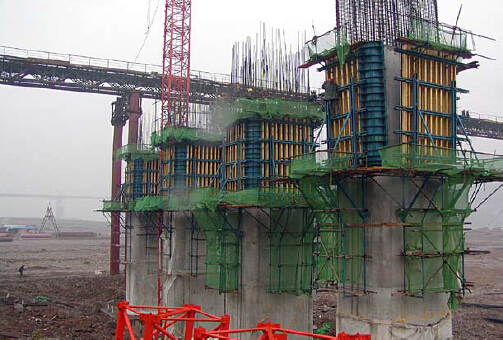
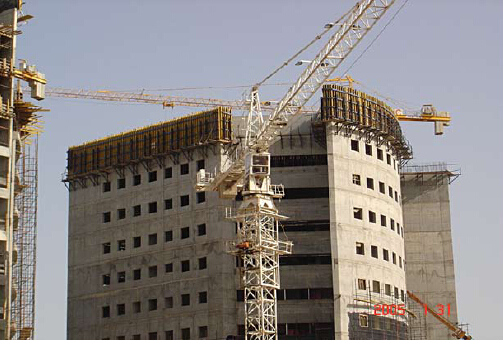
- Q: What are the different types of concrete finishes achievable with steel formwork?
- Different types of concrete finishes can be achieved using steel formwork, each offering a distinct aesthetic and functional appeal. 1. A smooth finish can be created on the concrete surface using steel formwork. This is often desired for walls, floors, and countertops, providing a sleek and polished look. Achieving this finish requires the use of high-quality formwork materials and precise installation techniques. 2. Various textured finishes can be achieved on the concrete surface with steel formwork. These textures can range from subtle patterns to more pronounced designs, adding visual interest and enhancing the overall appearance of the concrete. Architectural applications commonly utilize textured finishes to create a visually appealing and unique look. 3. An exposed aggregate finish can be achieved on the concrete surface using steel formwork. This involves removing the top layer of the concrete to reveal the aggregates, such as stones or pebbles, embedded within. Exposed aggregate finishes are popular for driveways, walkways, and decorative applications, as they provide a natural and textured appearance. 4. Steel formwork allows for stamped finishes on the concrete surface, resembling materials like brick, tile, or natural stone. This technique involves pressing molds or stamps onto the concrete before it fully sets, leaving imprints that replicate the desired pattern. Stamped finishes are commonly used for outdoor areas like patios and pool decks, offering a cost-effective alternative to natural materials. 5. Steel formwork can also be used to achieve an acid stain finish on the concrete surface. Acid staining involves applying a chemical solution that reacts with the concrete, creating unique and translucent colors. This finish is often desired in commercial and residential spaces where a more rustic and earthy look is preferred, as it enhances the natural variation and character of the concrete. In conclusion, steel formwork provides the opportunity to achieve a wide range of concrete finishes, including smooth, textured, exposed aggregate, stamped, and acid stain finishes. Each finish offers its own visual and functional benefits, enabling designers and architects to create customized and attractive concrete surfaces for various applications.
- Q: Is steel formwork reusable?
- Yes, steel formwork is reusable. Steel formwork is a type of temporary mold or structure that is used to hold wet concrete in place until it sets and hardens. Unlike other types of formwork, such as timber or plywood, steel formwork is known for its high durability and strength. The steel panels and frames are designed to withstand the pressure exerted by the wet concrete, ensuring that the formwork remains intact during the pouring and setting process. Due to its robustness, steel formwork can be reused multiple times, making it a cost-effective option for construction projects. After the concrete has set and the formwork is no longer needed, it can be dismantled and cleaned, ready to be used again on future projects. The reusable nature of steel formwork not only reduces waste but also saves money on material costs, as there is no need to continually purchase new formwork for each project. However, it is important to note that the reusability of steel formwork depends on proper maintenance and handling. Regular inspection and maintenance are necessary to ensure that the formwork remains in good condition and free from any defects or damage. Additionally, proper handling during dismantling and transportation is crucial to prevent any bending or distortion of the steel components. In conclusion, steel formwork is indeed reusable, which makes it a sustainable and cost-effective choice for construction projects. Its durability and strength allow it to withstand multiple uses, reducing waste and saving money in the long run.
- Q: Can steel formwork be reused?
- Indeed, steel formwork has the ability to be reused. It is a material that is both durable and robust, capable of enduring multiple uses. Compared to other formwork materials like timber or plywood, steel formwork boasts a longer lifespan. One of its key advantages lies in its simplicity to dismantle and reassemble. This feature permits the formwork to be used again in different construction projects, thereby reducing the necessity for new materials and resulting in cost savings. Moreover, steel formwork exhibits resistance to weather conditions and moisture, which adds to its longevity. It can handle the pressure exerted by concrete during pouring and curing without any warping or deformation, ensuring a consistent and high-quality outcome. In addition, steel formwork is easily cleaned and maintained, rendering it suitable for reuse. After each use, the formwork can be cleaned and inspected to guarantee its viability for the next project. Any necessary repairs or replacements can be carried out to ensure its structural integrity. To sum up, due to its durability, strength, resistance to weather conditions, and ease of maintenance, steel formwork can be reused. By reusing steel formwork, not only are costs saved, but sustainable construction practices are also fostered by reducing waste and conserving resources.
- Q: What are the maintenance requirements for steel formwork?
- Regular cleaning and inspection are the key maintenance requirements for steel formwork. After each use, it is important to clean the formwork to remove any concrete residue, dirt, or debris. This can be achieved by using water and a mild detergent or, for tougher stains, a high-pressure washer can be employed. Additionally, it is crucial to inspect the formwork for signs of wear, damage, or corrosion. Prior to and after each use, a thorough examination should be conducted to ensure the structural integrity of the formwork. Any areas affected by rust or corrosion should be promptly treated by cleaning, sanding, and applying a rust inhibitor or paint to prevent further deterioration. Furthermore, it is necessary to regularly check the joints, connections, and fasteners of the formwork to ensure they are secure and functioning properly. Any loose or damaged components should be repaired or replaced as needed. Storage also plays a vital role in maintenance. To prevent rusting and corrosion, the formwork should be stored in a dry and well-ventilated area. It is recommended to stack the formwork correctly, leaving enough space between each piece to prevent deformation and promote air circulation. Lastly, it is essential to adhere to the manufacturer's instructions and recommendations for maintenance and care. This includes using the formwork within its designated load-bearing capacity, avoiding excessive impact or rough handling, and following any specific maintenance guidelines provided. By adhering to these maintenance requirements, the steel formwork can be maintained in optimal condition, ensuring its durability, reliability, and longevity for future construction projects.
- Q: How does steel formwork affect the overall efficiency of the construction process?
- Steel formwork can greatly enhance the overall efficiency of the construction process. This is primarily due to its durability, versatility, and ease of use. Firstly, steel formwork is incredibly strong and can withstand the weight and pressure of concrete without bending or warping. This allows for faster construction as there is no need to wait for the formwork to be repaired or replaced. Additionally, steel formwork can be reused multiple times, reducing the time and cost associated with constantly purchasing new formwork materials. Moreover, steel formwork is highly versatile and can be easily customized to meet the specific requirements of different construction projects. It can be easily adjusted, cut, and welded to create various shapes and sizes, allowing for greater design flexibility. This flexibility also enables faster construction, as the formwork can be quickly modified to accommodate changes in the construction plans. Furthermore, steel formwork is designed to be user-friendly, making it easier and faster for construction workers to assemble and dismantle. It is lightweight compared to other materials like wood or aluminum, reducing the physical effort required during installation and removal. The standardized components of steel formwork also make the assembly process more efficient and less time-consuming. In addition, steel formwork offers improved quality control and accuracy in construction. The smooth surface of steel formwork ensures a consistent finish on the concrete structures, reducing the need for additional finishing work. This not only saves time but also enhances the overall aesthetics of the construction project. Overall, the use of steel formwork significantly improves the efficiency of the construction process by reducing construction time, minimizing material waste, and enhancing the quality and accuracy of the final structures. Its durability, versatility, and ease of use make it an ideal choice for both large-scale and small-scale construction projects.
- Q: How is steel formwork manufactured?
- The desired formwork structure is created by shaping and assembling steel components through a series of processes in the manufacturing of steel formwork. High-quality steel is first chosen and then cut and shaped into panels, beams, and connectors. To fabricate the panels, steel sheets are cut to the required size and shape using specialized cutting tools like shears or plasma cutters. These panels are then further processed to create necessary openings for connectors and accessories. Once the panels are prepared, they are assembled using connectors and fasteners. Welding, bolting, or riveting may be used depending on the specific design and requirements of the formwork. The connections are made carefully to ensure the strength and stability of the steel formwork structure. Beams and other support components are also included in the steel formwork. These are fabricated separately and integrated into the formwork system during assembly. Beams are designed to bear heavy loads and provide additional stability. After assembly, a quality inspection is conducted to ensure that the steel formwork meets required standards and specifications. Defects such as cracks or deformations are checked for, and the accuracy of dimensions and connections is verified. Once the steel formwork passes inspection, it is typically surface-treated to enhance durability and resistance to corrosion. Techniques like galvanizing or painting create a protective layer on the steel surface. In summary, the manufacturing process of steel formwork involves precision cutting, shaping, and assembling of steel components to create a strong and reliable system for concrete construction. The use of high-quality materials and attention to detail ensures that steel formwork meets the demands of various construction projects, providing a robust and reusable solution for concrete formwork needs.
- Q: What are the weight limitations of steel formwork?
- Various factors such as the type and thickness of the steel, the design of the formwork system, and the support structure determine the weight limitations of steel formwork. Steel formwork is generally recognized for its high load-bearing capacity and its ability to withstand substantial weight. For instance, concrete loads ranging from 50 to 100 kN/m² (10 to 20 pounds per square foot) can typically be supported by steel formwork systems. However, it is essential to refer to the manufacturer's specifications and guidelines for the specific formwork system being used, as they may have their own weight limitations. Moreover, the weight limitations can also be influenced by the dimensions of the formwork panels, such as their height and width, as well as the spacing and strength of the supporting beams or columns. The reinforcement provided for added stability is another factor that can affect weight limitations. In conclusion, steel formwork is renowned for its strength and its ability to withstand significant weight. However, the weight limitations may vary depending on the specific formwork system and its design, as well as the support structure. It is crucial to adhere to the manufacturer's guidelines and consult with structural engineers to ensure the safe and efficient utilization of steel formwork.
- Q: Can steel formwork be used for underwater concrete structures?
- Yes, steel formwork can be used for underwater concrete structures. Steel is a durable and strong material that can withstand the pressure and corrosive effects of water. It provides a reliable support system for pouring and shaping concrete in underwater conditions, ensuring the stability and integrity of the structure.
- Q: Are there any fire safety considerations when using steel formwork?
- When using steel formwork, it is crucial to take fire safety into account. Steel is a non-combustible material, meaning it does not burn or contribute to the spread of fire. However, it can lose its strength and structural integrity in high temperatures during a fire, potentially leading to structural failure, collapse, and the risk of injuries or fatalities. To mitigate these risks, it is necessary to implement proper fire safety measures. Considerations include: 1. Fire-resistant coatings: Applying fire-resistant coatings to the steel formwork helps protect it from heat and reduces the risk of structural failure during a fire. These coatings can offer additional fire resistance and be rated for specific fire durations. 2. Adequate fire protection systems: Installing and maintaining fire protection systems, such as sprinklers, fire extinguishers, and fire alarms, is essential for early fire detection and suppression. This prevents the fire from reaching the steel formwork and minimizes structural damage. 3. Fire-resistant barriers: Installing fire-resistant barriers, like fire-rated walls or partitions, contains the spread of fire and provides extra protection to the steel formwork. These barriers limit exposure to high temperatures and minimize the risk of structural failure. 4. Regular inspections and maintenance: Regularly inspecting the steel formwork for damage or corrosion is crucial to identify potential weak points that compromise its fire resistance. Promptly addressing any issues and repairing or replacing damaged sections is necessary. 5. Adequate fire escape routes: Ensuring accessible and well-marked fire escape routes near the steel formwork is vital for workers' safety in case of a fire. These routes should be obstruction-free and easily accessible for quick evacuation. Implementing these fire safety considerations significantly reduces the risk of structural failure and injuries associated with steel formwork. It is important to adhere to local building codes and regulations and consult fire safety professionals to ensure appropriate fire protection measures are in place.
- Q: What are the common types of form ties used with steel formwork?
- Steel formwork utilizes various types of form ties to hold the formwork together and guarantee the stability and strength of the concrete structure. 1. The most commonly used form ties in steel formwork are snap ties. These ties consist of a metal rod with cones or flat disks on each end. They are inserted through holes in the formwork panels and secured in place using a wedge or pin. Snap ties are popular in formwork construction due to their easy installation and removal. 2. Another type of form tie is the flat tie, which is similar to a snap tie but has a flat plate on one end instead of a cone. The flat plate provides a larger surface area for load distribution, making it suitable for heavy-duty applications. Flat ties are commonly employed in large-scale construction projects that require high strength and stability. 3. Waler ties are used to connect the formwork panels to horizontal beams known as walers, which support the formwork. These ties, usually made of steel bars or rods, are secured to the formwork panels using bolts or clamps. Waler ties distribute the load evenly across the formwork system, providing additional support and stability. 4. Coil ties are flexible ties made of wire coils. They are used to secure opposing formwork panels together. The coil ties are inserted into the formwork panels and twisted at both ends to secure them in place. Coil ties are cost-effective and user-friendly, making them a popular choice for small-scale construction projects. 5. Cone ties resemble snap ties but have a cone-shaped end on one side. This design allows for easy insertion and removal of the tie. Cone ties are typically utilized in situations requiring frequent formwork assembly and disassembly, such as the construction of temporary structures or formwork systems used in precast concrete production. These represent some of the common types of form ties used in conjunction with steel formwork. The selection of a suitable form tie depends on various factors, including the project's size and complexity, the required strength and stability, and the ease of installation and removal. Choosing the appropriate form ties is essential to ensure the safety and efficiency of the formwork system.
Send your message to us
Single-Side Climbing Bracket for formwork and scaffolding systems
- Loading Port:
- Tianjin
- Payment Terms:
- TT OR LC
- Min Order Qty:
- 50 m²
- Supply Capability:
- 1000 m²/month
OKorder Service Pledge
OKorder Financial Service
Similar products
Hot products
Hot Searches
